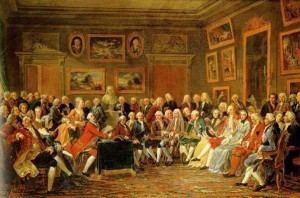
The French Revolution is an event of great historical significance. Its ideas and outcomes shaped not only the development of France but the history of Europe. Because of its significance, the French Revolution has been studied by hundreds of historians. Few historical periods or events have been studied more and been interpreted so differently. As a consequence, the historiography of the revolution is complex. Any student or historian who seeks an understanding of the French Revolution and its contrasting perspectives faces a number of challenges. This article contains a brief introduction to French Revolution historiography. It is a summary of how different historians and movements have interpreted the revolution over time, not a comprehensive or rigorous discussion.
The first interpretations of the French Revolution were written as the revolution itself was unfolding. Perhaps the best known contemporary accounts of the revolution was penned by Anglo-Irish politician and philosopher Edmund Burke (1729-1797). In late 1790 Burke published an extended essay called Reflections on the Revolution in France. Burke criticised the developments in France, condemning the revolution to fail and predicting – correctly, as it turned out – that it would end in tyranny and violence. Burke was a conservative and believed that political change must be cautious, considered and well founded. He viewed political systems as organisms that must grow and evolve slowly. As a consequence, Burke favoured moderate and cautious reforms that did not threaten or weaken the foundations of government and society. In Reflections on the Revolution in France Burke claimed the unfolding changes in France were too radical and ambitious; they made changes that could not be sustained and unleashed forces that could not be controlled. In Burke’s view the development of the revolution was too spontaneous, too disordered, lacking in leadership and devoid of planning. The French Revolution was not based on rational principles, Burke argued, so it would deteriorate into anarchy.
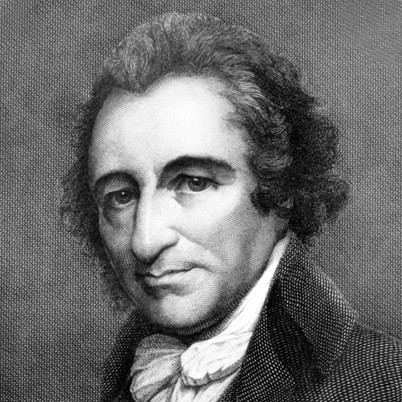
A contrasting contemporary view can be found in the writings of Thomas Paine (1737-1809). A Briton who emigrated to Pennsylvania, North America in 1774, Paine became a political journalist and a revolutionary himself. He contributed to the development of the American Revolution with powerfully worded essays that encapsulated revolutionary ideas. Paine’s 1776 essay Common Sense used plain but forceful language to rationalise ideas like republicanism, representative government and American independence. Paine’s Common Sense had a similar effect in America as Emmanuel Sieyès‘ What is the Third Estate? did in France, clarifying ideas and focusing attitudes at a pivotal time. Unlike Burke, Paine was a political radical who believed in republicanism and universal democracy. Consequently he was a supporter of the French Revolution, rather than a critic of it. Outraged by Burke’s arguments in Reflections on the Revolution in France, Paine responded with his own interpretation of the French Revolution. Rights of Man was published in two parts in 1791 and 1792. Paine argued that before 1789 France was a despotic aristocracy, wedded to inequality and privilege, addicted to war and stifled by its disregard for ordinary people. The only remedy for this, Paine argued, was a revolution from the ground up, in order to rebuild government and society.
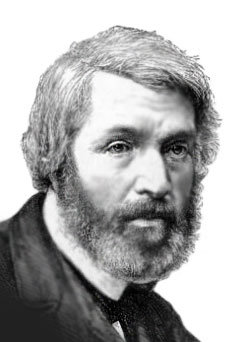
During the 19th century the best known British historian of the French Revolution was Thomas Carlyle (1795-1881). Born in Scotland and trained as a mathematics teacher, Carlyle turned his hand to philosophy and history in his late 20s. The restoration of the Bourbon monarchy in 1815 prompted Carlyle to begin writing a history of the French Revolution. It was delayed by several years when a housemaid accidentally used Carlyle’s first draft to start a fire, forcing him to rewrite it from scratch. The French Revolution: A History was eventually published in 1837. Unlike previous histories of the revolution, which were written in dry and bland tones, Carlyle’s account was colourful and dramatic, filled with poetic language, florid expression and metaphor. He was not afraid of depicting violence in graphic terms or casting judgement on revolutionary figures, sometimes in strong terms. Politically, Carlyle saw the events of 1789-91 as the true revolution. The monarchy and aristocracy were filled with incompetence and corruption, Carlyle believed, and got what they deserved. Carlyle despised the radical phase and particularly the “sea-green incorruptible” Robespierre, who presided over the Reign of Terror with ruthlessness and disregard for humanity. Carlyle’s history of the revolution proved popular with the general public and some historians. Many academics savaged its writing style, however, claiming that Carlyle had blended history with romantic literature.
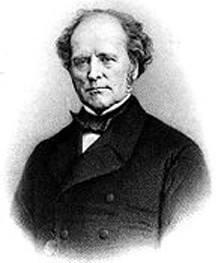
One of Carlyle’s contemporaries was French historian François Mignet (1796-1884). Born in the dissident Vendée region, Mignet was the son of a locksmith and was raised in an atmosphere of bourgeois liberalism. He trained as a lawyer but turned to history, beginning a study of the revolution in his mid 20s. Mignet’s 1924 text Histoire de la Révolution Française (‘History of the French Revolution’) was determinist in its approach (“the revolution was impossible to avoid”) and liberal in its political perspective. The bourgeoisie are Mignet’s true revolutionary heroes: their uprising in 1789 was an inevitable and overdue response to rising inequality, corruption and France’s bloated aristocracy. From the National Assembly to the National Guard and beyond, Mignet praises bourgeois revolutionaries and is forgiving of their faults and errors. He treads lightly when describing the radicalism of the later revolution. For Mignet, the revolution should not be judged by its radicals, its street mobs or its guillotines. Unlike Carlyle, who condemned the bloodthirstiness of the sans-culottes, Mignet attributes the bloodshed of 1793-94 to difficult conditions rather than inherently violent people.

Another prominent historian of the 19th century was Jules Michelet (1798-1874). The son of a struggling Paris printer, Michelet’s father saved enough to provide him with a university education. He obtained a position at the Collège Sainte-Barbe while still in his early 20s and later tutored the daughters of French royalty. Michelet did not attempt much serious historical writing until the 1830s. In the last half of his life he produced several significant historical works, including The History of France (1844) and History of the French Revolution (1847). Ideologically Michelet was liberal, republican, anti-clerical and socially progressive. He saw the revolution as a necessary event that attempted to advance government and society, based on the sound ideas of the Enlightenment. More democratically minded than Mignet, he expressed faith in the people – even the Jacobins, who in Michelet’s view were acting with good intentions to defend the republic. Michelet’s radical liberalism was sometimes controversial. In 1851 his lectures at the Collège de Paris were suspended, after complaints and objections to their content. He was dismissed from the Collège soon after and forced into retirement.
The novelists

Charles Dickens (1812-1870) was an English author of fiction, rather than a historian. Dickens deserves mention here, however, because one of his books helped shape recent views of the revolution, particularly in Britain. Published in 1859, A Tale of Two Cities was a bleak, humourless historical novel. A clear departure from Dickens’ other works, it contains a fictionalised account of revolutionary France, described in comparison with late 18th century London. For historical details Dickens relied on Thomas Carlyle’s The French Revolution: A History (he later admitted reading this book “five hundred times” as preparation). A Tale of Two Cities begins with its famous opening line “It was the best of times, it was the worst of times” before going on to paint a grim picture of both the Ancien Régime and revolutionary France. Dickens’ narrative suggests the French Revolution was an inevitable product of aristocratic privilege and exploitation – however the revolution, held captive by the troubled and seedy world of Paris, soon deteriorated into anarchy, mob rule and state-sanctioned violence.
Another novelist who influenced public perceptions of the French Revolution was Emma Orczy, later Baroness Orczy (1865-1947). From a family of Hungarian aristocrats who sought refuge in London, Orczy married a young Englishman in 1894. Short of money, she began writing novels and short stories around the turn of the 20th century. The most successful of these stories was The Scarlet Pimpernel, which appeared in 1903 as both a novel and a play. Essentially an adventure story, The Scarlet Pimpernel tells of an English playboy who rescues endangered aristocrats from France during the Reign of Terror. These rescues are usually achieved with clever disguises, brilliant swordsmanship and other daring feats. Orczy demonstrates a negative view of the revolution, based on her portrayals of class. Her aristocratic characters, for the most part, are decent, generous and enlightened – or in the case of the French nobles, hapless victims. The revolutionaries, by contrast, are stereotypes of the working classes: coarse, bloodthirsty and easy to fool.
Marxist interpretations dominated the historiography of the French Revolution for much of the 20th century. To Marxist historians, the tumult in France began as a bourgeois revolution. It was driven by class struggle between the rising bourgeoisie and the aristocracy, and marked France’s transition from feudalism to capitalism. The bourgeois revolutionaries sought two things: access to government and political power, and economic reforms amenable to their business interests. They advocated a liberal society where individual rights and freedoms were protected – but they were reluctant to share these rights and freedoms with the working classes. Because bourgeois deputies dominated the National Constituent Assembly, most of the Assembly’s reforms and policies reflected the social and economic interests of the capitalist class.
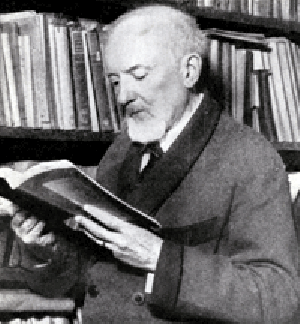
The 20th century’s most prominent Marxist historian was Georges Lefebvre (1874-1959). Lefebvre is best known for describing the French Revolution in four stages or phases, each driven by different classes and class interests. The ‘aristocratic revolution’ of 1787-88 saw the noble class challenge the power of the monarchy and force the king to summon the Estates General. The ‘bourgeois‘ revolution unfolded at the Estates General, where representatives of the affluent Third Estate demanded political representation and a national assembly. The ‘urban revolution‘ erupted on the streets of Paris in mid 1789 and was driven by the economic interests of the working classes. It corresponded with the ‘peasant revolution’ against feudal dues and economic conditions, which manifested as the Great Fear. Unlike previous historians Lefebvre and his fellow Marxists looked at “history from below” (a phrase Lefebvre apparently coined). Much of his research was concerned with how ordinary people, particularly peasants, responded to revolutionary ideas and participated in revolutionary events. At the time of Lefebvre’s death he was arguably the world’s foremost expert on the French Revolution.
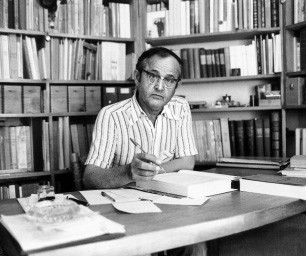
Lefebvre’s view of the revolution was echoed by other historians of the 1900s. One was a friend and former student of Lefebvre named Albert Soboul (1914-1982). An Algerian-born Sorbonne academic, Soboul saw the revolution as the product of class grievances and struggles. He spent much of his professional life examining lower class groups and movements, particularly the sans-culottes, who were the subject of Soboul’s doctoral thesis and several of his books. Soboul’s ground breaking research brought the sans-culottes to the forefront of the revolution – just as Lefebvre’s research had done for the peasantry. Soboul did not consider the sans-culottes a class. In his view they were a loose coalition of artisans, labourers and petit bourgeoisie who, despite their differences and internal tensions, became united against the aristocracy and wealthy commoners. Yet both the Montagnards and sans-culottes were motivated by class interests. The sans-culottes demanded price controls, action against hoarders and speculators, production quotas and a stable currency. The Girondins, who were more representative of the bourgeoisie and favoured free market economic policies, opposed these measures. Like other Marxist historians Soboul considers the Reign of Terror a desperate response to war and dire economic conditions. The arrest of Robespierre and the end of the Terror marked the return to the bourgeoisie to political power.
Marxist interpretations prevailed in the 20th century but they did not go unchallenged. Several revisionist historians emerged and confronted the Marxist orthodoxy. One of the most notable revisionists was Alfred Cobban (1901-1968). A Cambridge-educated Englishman, Cobban was professor of French history at University College, London for more than 30 years. As a historian Cobban aimed for a common sense approach to the revolution, free of class-based motives and assumptions. He saw the events of 1789 as a political revolution with social consequences. It was not, as Marxist historians often suggested, undertaken to implement a freer form of capitalism. Late 18th century France was already a rising capitalist economy, Cobban argued; many Third Estate deputies had grown rich from capitalist enterprises long before 1789. Cobban also pointed to the lack of decisive economic policy in the new regime – and the fact that French capitalism stagnated rather than improved in the early 1790s. Cobban’s argument was supported by George V. Taylor, an American historian. Taylor pointed out that many nobles were actually progressive capitalists, while many bourgeois revolutionaries were scarcely capitalist at all.

Within France the best known revisionist historian was François Furet (1927-1997). Born in Paris, Furet became an active communist after World War II before abandoning communism in his late 20s. In 1965 Furet, in collaboration with his brother-in-law Denis Richet, published his first significant work on the revolution, La Révolution Française. This book shunned Marxist interpretations, examining the revolution from a position more aligned with liberals like Alexis de Tocqueville. According to Furet, the revolution began as an expression of liberal-democratic principles but had moved off course by 1792. The term Furet used was dérapage, a French word meaning ‘skid’ or ‘slide’. Because the revolution had no decisive or unifying leadership, it became a series of unexpected events, responses and reactions, class tensions and factional conflict. As this tension and conflict worsened in 1792-93 the revolution disintegrated into terror and anarchy. While Marxist historians claimed the Reign of Terror was a valid response to internal and external opposition, Furet argued that terror was ‘built in’ to revolutionary action from its early days. The power of the Jacobins and sans-culottes in 1793-94, Furet argued, was intrinsically connected to mob violence.
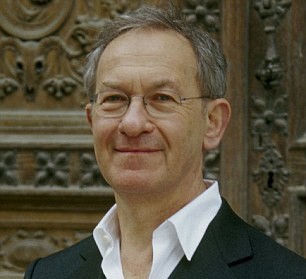
The bicentenary of the French Revolution in 1989 inspired a new wave of histories. One of the more successful was Citizens by British historian Simon Schama. A general release book rather than a piece of academic research, Citizens marked a return to centre stage of narrative history, filled with colour, drama and suspense but light on theory and intensive analysis. Schama’s approach to writing history, along with his interpretations of the revolution, were not to everybody’s taste. Politically Schama is a liberal-conservative whose perspectives of the revolution align with those of Edmund Burke and Alexis de Tocqueville. He claims the French Revolution began as a “whispering campaign” based on a false premises. The objectives of 1789 were honourable enough – but the revolution was too disorganised, leaderless and reliant on violence to bring about political change. Citizens is more sympathetic to Louis XVI, the aristocracy and political conservatives than other histories. Conversely, it despises radical figures like Jean-Paul Marat and Robespierre, who were totalitarian in their outlook but myopic and out of their depth. Narrative accounts of the revolution have also been produced by historians such as Christopher Hibbert and Sylvia Neely.
Feminist perspectives

The last 40 years have seen the emergence of new interpretations of the French Revolution. Feminist historians have produced some interesting perspectives about how the revolution involved, marginalised and affected women. The general consensus is that the revolution did little for French women and in some respects pushed them backwards. The American scholar Joan B. Landes, for example, has argued that aristocratic women wielded a degree of political influence – but that the instruments of government and revolutionary organisation, which were controlled by men, suppressed this. The ideas of the revolution, Landes contends, were both economically bourgeois and socially conservative. Instead of relaxing the constraints on French women, the revolution actually preserved and reinforced gender differences and barriers.
Historians like Olwen Hufton and Dominique Godineau have also examined the role of working class women, particularly female sans-culottes and peasants. These women were politically active between 1789 and 1792 but their activism was eventually taken over and smothered by the radicalism of the Jacobins in 1793. The French academic Catherine Marand-Fouquet argues that the demands of revolutionary women have been trivialised and reduced to complaints about prices, food and hunger. Marilyn Yalom suggests that the French Revolution not only excluded women, it made them more dependent on men – and thus more economically fragile and prone to suffering. Annette Rosa offers a dissenting point of view, suggesting that during the revolution French women acted as de facto citizens. She believes that the erosion of church power and reforms to civil law liberated women to a degree, making marriage less binding and restrictive than it had been.
© Alpha History 2018-2023. Content on this page may not be republished or distributed without permission. For more information please refer to our Terms of Use.
This page was written by Jennifer Llewellyn and Steve Thompson. To reference this page, use the following citation:
J. Llewellyn and S. Thompson, “French Revolution historiography”, Alpha History, accessed [today’s date], https://alphahistory.com/frenchrevolution/french-revolution-historiography/.
